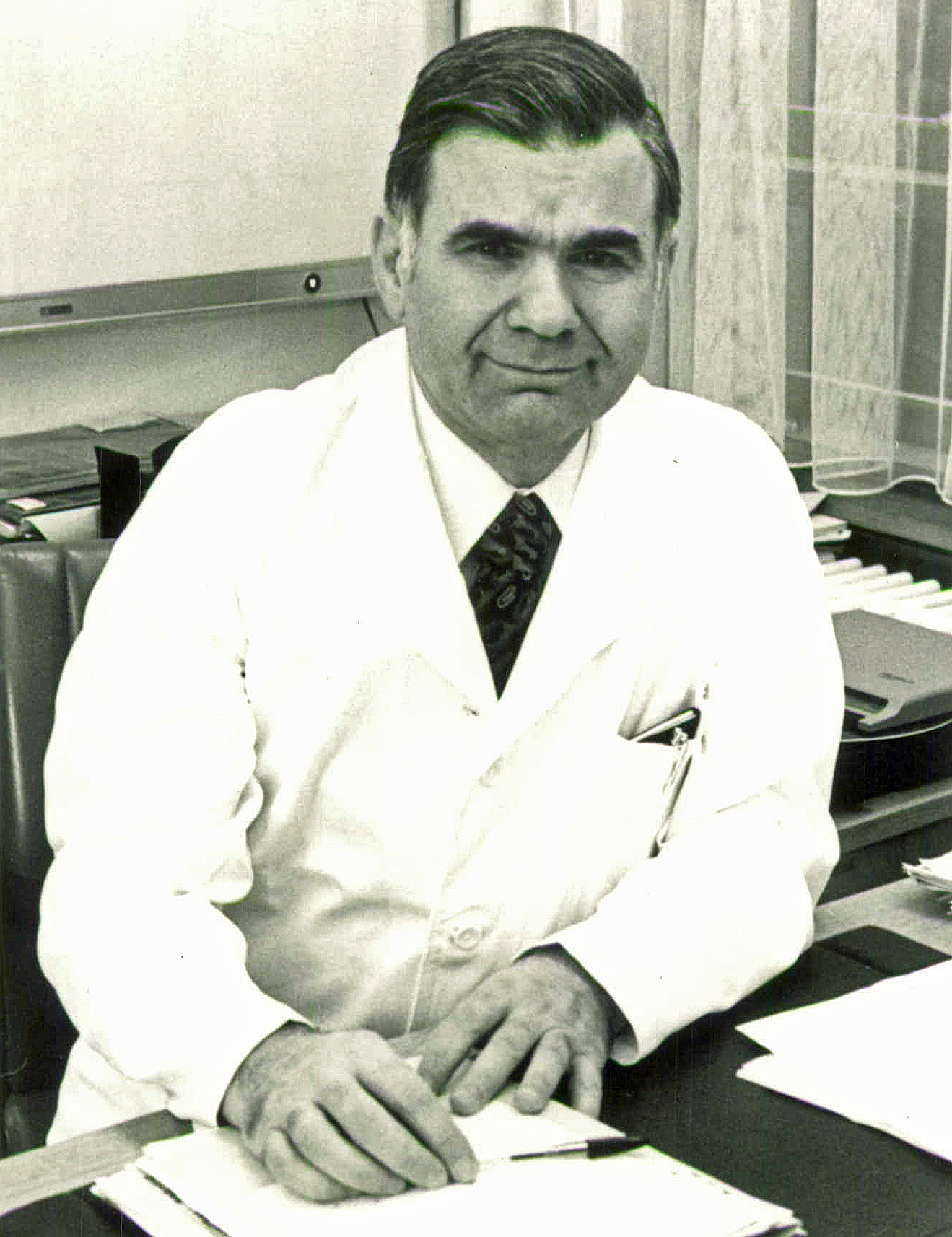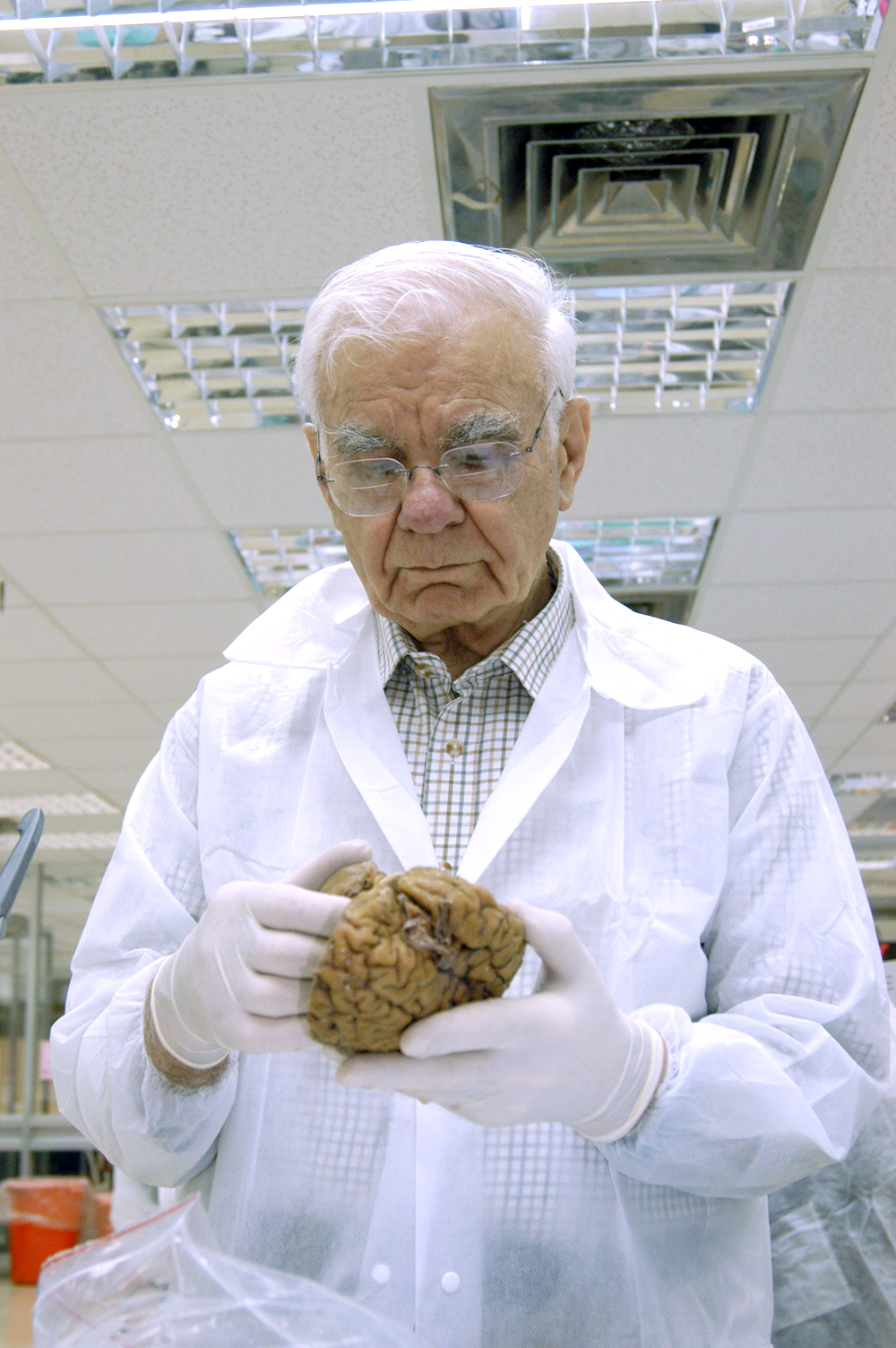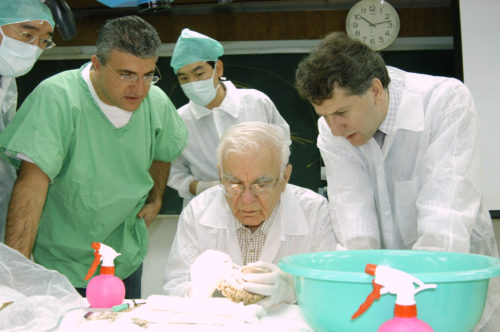Mahmut Gazi Yaşargil: Micro-Surgery, Neurologic Pioneer
We’re at number 35 in our countdown of the top 50 most influential doctors in history and have come to a physician born in a cave, at gunpoint, in Eastern Turkey where his parents were being held by revolutionary/outlaws determined to challenge the new Turkish government in Ankara.
Born “baby” Yaşargil on July 6, 1925 he went on to become Neurosurgery’s Man of the Century (1950–1999) for his revolutionary achievements and advancements in micro-surgery; but… we get ahead of ourselves.
Dr. Mahmut Gazi Yaşargil with “students” in the neuroanatomy laboratory
His father, the district governor, was eventually rescued by government troops and petitioned and received the government’s permission to use the restricted name: “Gazi” for his son. The name has multiple origins but in Arabic has to do with “warrior” or “fighter”: Mahmut Gazi Yaşargil.
Mahmut Gazi Yaşargil (1925 – ) – #35
Neurosurgery’s Man of the Century, Humanitarian, Educator
Lice, Diyarbakır, Turkey was a small town of 5,000 people which, in 1925, had: an infant mortality of 165 per thousand live births, a new government (Turkey), a new alphabet (switched from Arabic to Western) and a new “Mahmut Gazi Yaşargil.”
Early Life and Education of Mahmut Gazi Yaşargil
Not unexpectedly his parents moved from the troubled Lice to the capital Ankara three months later where he grew up being exposed to “magnificent things and opportunities” by a father who “doted on academic things” and a steady stream of visitors who discussed many diverse subjects including medicine and neurology—because, one friend was a neurologist.
Loosing their brother Ihsan to abdominal typhus inspired the remaining three, two boys and a girl, to study medicine and become professors in various fields.
From 1931 to 1943 Gazi attended Ankara public schools and Gymnasium (high school and college), graduating at 18; and, like the many others just trying to live their lives in spite of Hitler, headed to Vienna to study medicine.
Nazi police suspected him of being a Jew so he was not allowed to register for classes; but, instead of returning to Turkey, he pushed on into Germany and served as a “nurse-helper” for 6 months until he could bargain for enrollment as a first-year medical student at the Friederick von Schiller University.
For two years he was harassed by Hitler’s police as a potential spy and his being headstrong and confident just made matters worse. Allied bombs killed some of his classmates but he survived into 1945 when he was able to secure a seat at the University of Basle, Switzerland School of Medicine going on to graduate in 1950.

He was mentored by a professor in psychiatry, Muller, and leaned toward that field but felt that it wasn’t quite “precise” enough for his mathematical mind.
During his 1951 and 52 residency in internal medicine and general surgery he did research on brain anatomy and gradually began to focus toward neurologic surgery—for which the world is very grateful.
You see, in 1953 he began training in neurosurgery in Zürich where he helped develop stereotactic and epilepsy procedures. In ’65 he was granted a 15 month sabbatical to work in Burlington Vermont USA learning microvascular surgery on limbs—40 years old already with 13 years experience in neurosurgery.
He finished the initial 3 month experience phase in 6 weeks and went on to not only perform many surgeries but develop new neurovascular procedures (for which he became famous), invent new surgical equipment and modified other newly invented equipment for use in the “micro-universe” of brain surgery.
He invented better ways to patch two vessels in the head together, modified the new bipolar coagulation devices for use on 0.5 to 2 millimeter vessels! He also began traveling through the USA organizing neurological courses with his associates all while he was becoming the most skilled surgeon in the world with the dissecting microscope—and the ancillary equipment he had developed himself.
Professional Career:
In ’67 he took his experience back to Zürich, performing 103 operations in the first year and beginning the iconic six-volume book: Microneurosurgery.
He loved Zürich and his hospital there. From 1953—when he became a resident then chief resident, to ’69—when he became an associate professor, to 1973—when he took over from his lifelong friend and mentor Prof. Krayenbuhl as professor and chairman of the Department of Neurosurgery.
He is described by his fellows and students as “totally devoted to the field of neurosurgery” and someone who has had his share of “rejection, disbelief and jealousy.” As he was quietly developing, inventing and performing, so-called “colleagues” could not believe what he was achieving because his results were so dramatically better than everyone else was getting.
But, more evil men than they (under Hitler) had failed to turn him away from his goals.
He married Dianne Bader-Gibson Yaşargil, who was “a brilliant English nurse” and the nurse in charge of the operating suite by his side since 1973. And, over the next 20 years he performed not only laboratory work and research but clinical applications as well, performing over 7500 intracranial operations in Zurich until he “retired” in 1993! Actually, he was only to begin a second career… in the U.S..
Later life:

He had been invited to join the neurosurgical department of the University of Arkansas in Little Rock; and, after finding out that they had just built and outfitted a superb neurosurgery facility, in 1994 moved to Arkansas, became a professor and began operating and teaching his techniques to a whole new group of eager students.
It was in Arkansas that he became recognized as “neurosurgeon of the century (1950-1999)” in the traditional Neurosurgery journal of the Neurosurgeons’ Congress and the Neurological Surgeons Medal of Honor.
He treats epilepsy and brain tumors with instruments of his own design. He earned a reputation for surgical dexterity and skill in developing tools to further his techniques—including the floating microscope, the self-retaining adjustable retractor, and ergonomic aneurysm clips and appliers, as well as various microsurgical instruments.
Every neurosurgical procedure performed today has been affected by his work, transforming surgical practice and outcomes, in many cases for patients who had previously been considered inoperable.
In 2014 he returned to the land of his birth and began leading the Brain Surgery Department of Yedditepe University in Istanbul; and at age 90 was still participating in microneurosurgery courses—which he created.
He has taught his secrets to over 3000 neurosurgeons, designed his own surgical tools and become an honorary citizen in three countries: Turkey, Argentina and the USA [Texas].
Biographic Summary
Mahmut Gazi Yaşargil was Neurosurgeon of the Century (1950-1999)
Born: July 6, 1925 in Lice, Diyarbakır, Turkey
Died: Living (2017)
Education: Friederick von Schiller University, University of Basle, Switzerland School of Medicine,
Known for: developing neurosurgical techniques, equipment and procedures as well as prodigious skill
Books: Published more than 250 papers and seven monographs; and a multi-volume textbook, Micro-Neurosurgery, which is still today the standard reference
Parents: (Names not given)
25 Posts in Top 50 Doctors (top50) Series
- 27 - Charles D. Kelman - Cataracts – 9 Mar 2023
- 28 - Cicely D. Williams, Kwashiorkor, Breastfeeding, Whistleblower – 21 Jun 2022
- 29 - Dame Cicely Saunders, Hospice – 23 Apr 2018
- 30 - David L. Sackett, Evidence-based Medicine – 2 Apr 2018
- 31 - E. Donnall Thomas & Joseph Murray, Bone Marrow Transplants – 23 Feb 2018
- 32 - Elizabeth Blackwell, women in medicine – 29 Jan 2018
- 33 - Elisabeth Kübler-Ross, stages of grief – 5 Jan 2018
- 34 - Watson & Crick, DNA – 2 Dec 2017
- 35 - Mahmut Gazi Yaşargil, Micro-Surgery – 24 Oct 2017
- 36 - George Papanicolaou, Cytopathology, Cancer – 29 Sep 2017
- 37 - Dr. James Parkinson, Parkinson's Disease – 1 Sep 2017
- 38 - Dr. John Snow, cholera – 20 Aug 2017
- 39 - Dr. Joseph Kirsner, GI Joe – 27 Jul 2017
- 40 - Lawrence (Larry) Einhorn, chemotherapy – 16 Jun 2017
- 41 - Robert Koch, modern bacteriology – 21 Mar 2017
- 42 - Stanley Dudrick, TPN – 28 Feb 2017
- 43 - Stanley Prusiner, neurodegenerative diseases – 25 Jan 2017
- 44 - Victor McKusick, medical genetics – 3 Jan 2017
- 45 - Virginia Apgar, anesthesiology & newborn care – 12 Nov 2016
- 46 - William Harvey, circulation – 12 Oct 2016
- 47 - Zora Janžekovič, burns – 26 Sep 2016
- 48 - Helen Taussig, blue babies – 3 Sep 2016
- 49 - Henry Gray, anatomy – 3 Jul 2016
- 50 - Nikolay Pirogov, field surgery – 11 Jun 2016
- Top 50 Doctors: Intro/Index – 10 Jun 2016

